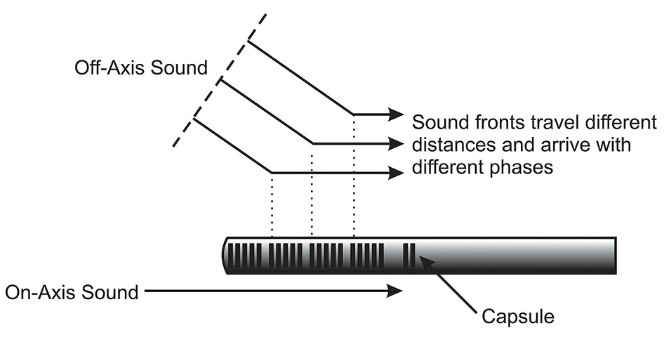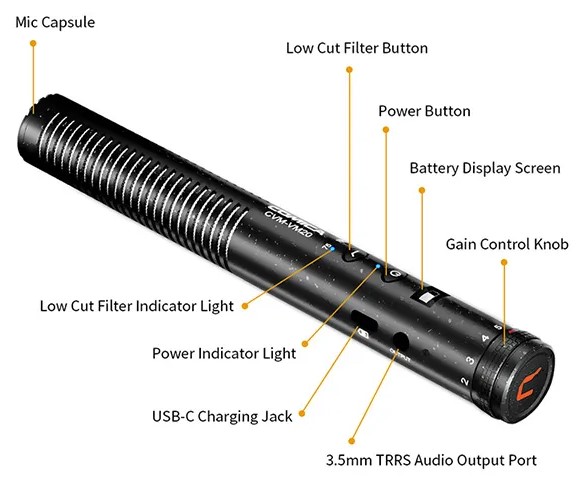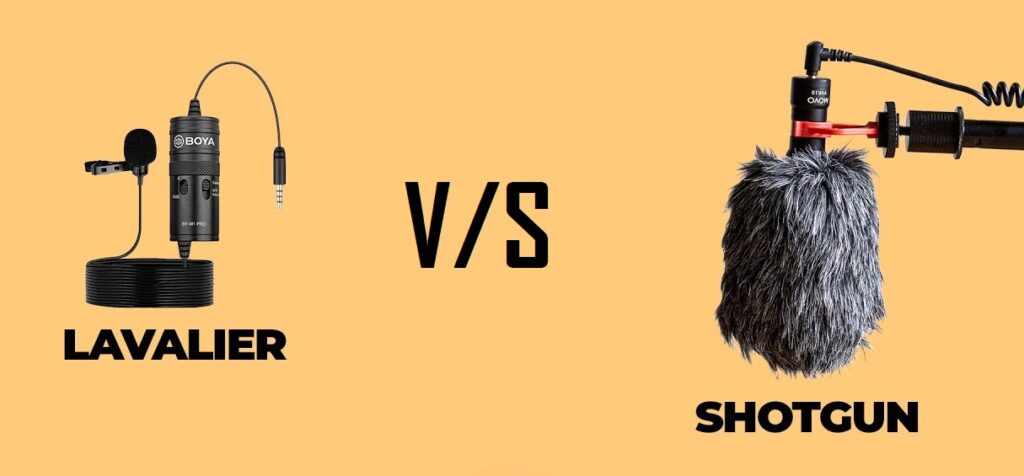When it comes to achieving audio excellence across diverse recording environments, one name consistently rises to the top – the shotgun microphone. These specialized marvels of audio technology are the preferred choice for both seasoned professionals and passionate enthusiasts. Their exceptional directional precision allows them to zero in on the intended sound source while elegantly sidestepping unwanted noise from all other angles.

In this all-encompassing guide, we embark on a journey through the fascinating universe of shotgun microphones, unraveling the science behind their design, investigating their wide-ranging applications, and providing practical insights to wield them with mastery. Whether you’re a filmmaker, sound engineer, content creator, or simply someone with a passion for top-tier audio, this guide is your gateway to the world of pristine sound capture.
Shotgun Microphone At A Glance
A shotgun microphone, often referred to as a boom microphone, is a highly specialized type of microphone designed for superior directional audio capture. Unlike omnidirectional or cardioid microphones that capture sound evenly from all directions or a specific area, shotgun microphones excel at pinpointing and recording sound sources in a specific direction.

Parts of a Shotgun Microphone
A shotgun microphone consists of several essential components, each playing a crucial role in capturing and processing audio with precision. Here are the main parts of a shotgun microphone:
Microphone Capsule
The microphone capsule is where the magic begins. It consists of a diaphragm and a backplate. When sound waves hit the diaphragm, it vibrates in response to the variations in air pressure caused by those waves.

The diaphragm’s vibrations are extremely tiny, but they are crucial as they convert acoustic energy into electrical signals. This conversion process is the fundamental function of any microphone and is where the audio journey begins.
Interference Tube
The interference tube is a defining feature of shotgun microphones. It’s a slender, slotted cylinder located in front of the microphone capsule. The tube’s purpose is to create a highly directional pickup pattern. It does this through a process called phase cancellation. As sound waves enter the tube, they undergo phase interference.

This results in a highly focused pickup from the front, where the desired sound source is, while rejecting sound from other angles. The length and design of the interference tube are critical factors in determining the microphone’s directional characteristics.
Circuitry and Electronics
Inside the microphone’s body, you’ll find an array of electronic components responsible for amplifying and processing the audio signal. These components include amplifiers, impedance converters, and sometimes filters.

The circuitry ensures that the electrical signal generated by the microphone capsule is robust, clean, and properly matched to the input of recording equipment or sound systems.
Output Connector
The output connector is where the microphone’s electrical signal is made accessible for connection to recording devices or sound systems. Common connectors for shotgun microphones include XLR, mini-XLR, or USB, depending on the microphone’s design and intended use. The choice of connector depends on the microphone’s compatibility with specific recording equipment.

Body and Housing
The microphone’s body and housing encase and protect the internal components. These exteriors are typically constructed from metal or high-quality plastic to ensure durability and resistance to wear and tear.

The design of the body is also engineered to minimize handling noise and other external factors that could interfere with the audio recording.
Grille or Windscreen
Positioned at the front of the microphone, the grille or windscreen serves both protective and functional purposes. It guards the delicate capsule and internal components against dust, debris, and physical damage.

In outdoor recording scenarios, the grille may also include a built-in windscreen or be accompanied by additional wind protection accessories. These elements are crucial for reducing wind noise during recording.
Shock Mount
Many shotgun microphones come with shock mounts or suspension systems. These are vital for isolating the microphone from vibrations and handling noise.

Shock mounts typically use elastic bands or rubberized suspensions to provide a cushioning effect, ensuring that vibrations from handling or external sources do not reach the microphone capsule and distort the recording.
Wind Protection
Shotgun microphones often include wind protection accessories, such as foam windscreens or furry windjammers. These are particularly important for outdoor recording, where even a gentle breeze can introduce unwanted wind noise into the recording.

Each component of a shotgun microphone plays a vital role in its ability to capture highly directional and precise audio. From the capsule’s initial conversion of sound waves into electrical signals to the interference tube’s phase cancellation, and from the circuitry’s signal processing to the protection offered by the body and windscreen, every part contributes to the microphone’s overall performance and utility in various recording scenarios.
How Shotgun Microphones Work
At the heart of a shotgun microphone’s design is its interference tube. This tube is a long, slotted cylinder that runs parallel to the microphone capsule. Sound waves entering the tube undergo phase cancellation, effectively creating a highly directional pickup pattern. This means that sounds originating from the front are captured clearly, while those from the sides and rear are significantly attenuated.

Shotgun microphones feature a specialized directional capsule, typically supercardioid, enhanced by a distinctive long, slotted ‘interference tube’ affixed to its front. While this design naturally positions the capsule at a greater distance from the sound source, potentially affecting the direct-to-reverberant ratio, the trade-off is justified by the tube’s superior high-frequency directionality, effectively minimizing ambient noise for pristine audio capture
Mechanism of Interference Tube
The interference tube concept functions by allowing the desired on-axis sound to pass unobstructed through the tube to the capsule diaphragm. Meanwhile, unwanted off-axis sound must navigate the side slots of the tube, entering multiple slots at varying distances from the diaphragm.

This path introduces different phase relationships among the off-axis sound components, resulting in partial cancellation, hence, the term ‘interference tube.’ As a result, off-axis sounds are effectively attenuated compared to on-axis sounds, yielding a narrower polar pattern at the front than achievable with a standalone supercardioid microphone.
An interference tube is a specialized acoustic component positioned in front of a microphone capsule to enhance directional sensitivity. Its fundamental principle involves allowing on-axis sound to reach the microphone membrane directly. Conversely, sound arriving from the microphone’s sides is subject to damping, owing to the varied path lengths inside the tube. Typically, the interference tube exhibits its highest directionality at higher frequencies.

Polar Plot of Shotgun Microphones
The polar response chart below provides a visual representation of a typical shotgun microphone’s directional characteristics. This plot offers insights into the microphone’s gain at various orientations relative to the sound source. The reference point at 0° corresponds to the microphone being precisely aligned with the sound source it’s recording. At this point, the microphone exhibits its maximum gain, in this example, measuring at -11dB.

As the microphone rotates away from the sound source, its gain progressively diminishes. The 180° reference point signifies the microphone facing entirely away from the sound source, pointing in the opposite direction. Here, the microphone registers its lowest gain, at -28dB in this instance. These gain patterns vividly demonstrate that a shotgun microphone delivers optimal sensitivity when precisely directed toward the sound source, and sensitivity decreases as it deviates from this ideal alignment.
The Concept of Directionality
A fascinating way to comprehend a microphone’s directional characteristics in relation to frequency is by examining its ‘directivity index’ (DI) graph. The DI quantifies the microphone’s ability to pick up sound on its primary axis compared to its sensitivity in all directions, expressed in decibels (dB). The greater the DI value, the more directional the microphone becomes.

For instance, an omnidirectional microphone registers a DI of 0dB, signifying its equal sound capture from all directions. On the other hand, a hypercardioid microphone boasts a DI of 6.0 dB, denoting its heightened directionality.
The following graph visually portrays the frequency at which a microphone’s directionality significantly increases, a factor contingent on its physical length. This DI graph provides a comparative analysis of three shotgun microphones: the VP89S (short), VP89M (medium), and VP89L (long). Notice how the cardioid pattern maintains consistent directionality across frequencies, while the shotgun microphones exhibit progressively enhanced directionality at lower frequencies, in direct proportion to the length of their interference tubes.

Types of Shotgun Microphones
Shotgun microphones, those versatile tools cherished by audio professionals and content creators, come in a trio of distinct types. Each type boasts unique attributes, allowing them to shine in specific recording scenarios.
Short Shotgun Microphones
Short shotgun microphones, often referred to as compact shotgun microphones, find their niche in the world of close-up shots. They embody a balanced design, offering a compromise between size and directionality. This balance makes them perfect for capturing sound sources situated relatively close to the microphone.

When you’re working on interviews, documentaries, or scenes in controlled environments where precision matters, short shotgun microphones are the go-to choice. Their moderate pickup angle ensures that you capture your subjects’ voices or sounds with remarkable clarity, enhancing the overall audio quality of your project.
Long Shotgun Microphones
Stepping up in length and directionality, long shotgun microphones specialize in long-range audio capture. These microphones are designed to excel when your sound source is more distant or when you require pristine audio quality without having to physically get closer to the subject.

Picture a sound engineer working on a film set, aiming to record dialogue between actors situated meters away. In such scenarios, long shotgun microphones become invaluable. Their extended reach allows you to capture audio from afar without compromising on the audio’s richness and fidelity.
Super Shotgun Microphones
At the pinnacle of shotgun microphone technology lie the super shotgun microphones. These represent the epitome of directionality and sensitivity, and they are favored by professionals across the film, television, and broadcasting industries.

Super shotgun microphones are exceptionally versatile, capable of delivering exceptional results in both close-up and long-range shots. They’re prized for their ability to isolate the target sound source with remarkable precision, effectively ignoring ambient noise and unwanted distractions using low-cut filters and gain controls.

Whether you’re capturing an intimate dialogue scene or capturing wildlife sounds in the wilderness, super shotgun microphones are trusted companions for those who demand nothing but the best in audio quality.
Choosing the Right Shotgun Microphone:
Selecting the appropriate shotgun microphone type depends on your specific recording needs. Consider the following factors when making your choice:
- Shot Type: Determine whether you primarily need close-up shots, long-range shots, or both. Short shotgun microphones are great for intimate, nearby scenes, while long and super shotgun microphones shine in expansive or distant settings.
- Polar Pattern: While shotgun microphones are highly directional, the specific polar pattern can vary. Some have a tighter pickup pattern than others, so choose one that suits your recording environment.
- Environment: Assess the recording environment. Is it controlled and quiet, or are there challenging conditions like wind and background noise? The choice of shotgun microphone can significantly impact your audio quality under varying conditions.
- Budget: Your budget will also play a role in your selection. Short shotgun microphones are often more budget-friendly, while super shotgun microphones can be a substantial investment.
- Mounting: Regardless of the type, proper mounting is essential to achieve the best audio quality. Consider using shock mounts or suspension systems to reduce handling noise and vibration.
Applications/uses of Shotgun Microphones
Shotgun microphones find applications in a wide range of scenarios:
- Film and Television Production: In the world of film and television, shotgun microphones are commonly mounted on boom poles and held just out of the frame to capture dialogue and sound effects with precision.

- Field Recording: Whether you’re recording wildlife sounds or location interviews, shotgun microphones are ideal for isolating your subject from ambient noise.

- Live Sound Reinforcement: Shotgun microphones can be used to capture the sound of specific instruments or vocals in a live performance setting while minimizing feedback.
- Broadcasting: News reporters and broadcasters frequently use shotgun microphones to capture clear and focused audio in noisy environments.

- Precise Interviews in Noisy Environments: Shotgun mics, with their unidirectional focus, excel at capturing interviews in noisy settings like train stations or airports. This reduces unwanted background noise during recording and streamlines sound editing by isolating essential audio.
Get Desired Results from your Shotgun Microphone
To get the best results from your shotgun microphone, follow these tips:
- Positioning: Point the microphone directly at the sound source to maximize its directional capabilities.

- Wind Protection: Use a foam windscreen or a furry windjammer to reduce wind noise in outdoor recordings.
- Shock Mount: Invest in a shock mount to isolate the microphone from vibrations and handling noise.
To make the most of your shotgun microphone, remember to point it directly at the sound source and keep it as close as possible without causing obstructions.
Advantages & Disadvantages of Shotgun Microphones
Advantages of Shotgun Microphones
- High Directionality: Shotgun mics excel at isolating the desired sound source while rejecting background noise.
- Versatility: They are suitable for various applications, including film, broadcasting, and interviews.
- Long Reach: Ideal for capturing audio from a distance while maintaining clarity.
- Natural Sound: Shotgun mics produce precise and natural audio recordings.
- Reduced Handling Noise: Equipped with shock mounts to minimize handling interference.
Disadvantages of Shotgun Microphones
- Limited Pickup Angle: They have a narrow pickup angle, potentially missing off-axis sound.
- Wind Sensitivity: Prone to wind noise outdoors, may need windshields.
- Cost: High-quality models can be expensive.
- Visibility: May be challenging to keep out of camera frames in some setups.
Shotgun Microphones vs. Lavalier Microphones
Both shotgun and lavalier (lapel) microphones have their strengths, making them valuable tools for various audio recording needs. They excel in scenarios like interviews, vlogging, and dialogues.

Lavalier Microphones
Lavalier microphones, which can clip onto a subject’s clothing, offer good signal-to-noise ratios, even in their omnidirectional variants. Wired lavalier mics conveniently plug into a 3.5mm jack, directly recording audio into video files. Wireless lavalier mics, while offering mobility, require transmitters and can be connected to a 3.5mm jack or an external mixer for later synchronization during post-production.
Shotgun Microphones
On the other hand, shotgun microphones, with their distinct form factor, bring versatility to the table. They often produce more natural audio compared to lavaliers. Additionally, their design allows you to keep them out of your camera’s frame, eliminating the need to hide microphones on actors, yourself, or interviewees.
Here’s a comparison table highlighting some key differences between shotgun and lavalier microphones:
| Shotgun Microphones | Lavalier (Lapel) Microphones | |
| Directionality | Highly directional, focused audio | Omnidirectional, varied options |
| Sound Quality | Natural and precise | Clear but may pick up ambient noise |
| Visibility | Often kept out of the frame | Usually visible when clipped |
| Form Factor | Longer, handheld or boom-mounted | Compact, clip-on designs |
| Ideal Use Cases | Outdoor shooting, distant subjects | Close-up interviews, mobility |
| Setup Complexity | Simple setup | Requires clipping and cable management |
| Versatility | Suitable for a range of scenarios | Effective for interviews and dialogues |
| Concealment | Not typically concealed | Visible when clipped to clothing |
Conclusion
In the dynamic realm of audio recording, shotgun microphones shine as precision instruments that unlock a world of auditory possibilities. From their inception with the innovative interference tube to their versatile applications across various industries, they stand as champions of clarity and focus.
These remarkable tools, with their highly directional prowess, serve professionals and enthusiasts alike. Whether you’re capturing dialogue in bustling settings, isolating distant sounds, or exploring the art of audio, shotgun microphones enhance your sonic journey. Remember, your choice of shotgun microphone, expertly utilized, can transform your recordings into audio masterpieces. Aim for precision, harness the power of phase cancellation, and elevate your audio game.
Your feedback is invaluable. Did this comprehensive guide enlighten your understanding of shotgun microphones? We welcome your insights, questions, and suggestions. Your reviews and feedback fuel our commitment to providing informative content that enriches your audio experience. Join our community’s ongoing conversation by sharing your thoughts below. Thank you for being a part of this sonic adventure!
While shotgun microphones excel in capturing clear directional audio, sometimes mobility and convenience are paramount. In such scenarios, pairing your audio setup with a compact wireless lavalier microphone offers flexibility, allowing talent to move freely without sacrificing sound quality.
Best Seller
Sale

Hollyland LARK M2S – Wireless Clip-on Microphone
- 7g Lightweight, Titanium Clip, Discreet Design
- Clear sound with 24-bit/48kHz, 70dB SNR, 116dB SPL
- Noise Cancellation & 300m Long-Range Stability
- Works with Camera/iPhone/Android/Laptop
- Perfect for Content Creators, Online-Teaching, Streaming
$139
$159
Frequently Asked Questions
What’s the difference between a shotgun mic and a boom mic?
A shotgun mic is often referred to as a boom microphone in video production. It’s widely used in cinema and television but less common in other audio-related professions. It features a highly directional shotgun/lobar pattern, ideal for pinpointing sound sources.
Are shotgun mics suitable for singing?
Medium shotgun mics work well for booming and voice pickup. Shorter shotguns, while less directional than longer ones, offer excellent off-axis rejection. They’re useful when minimizing length is essential, providing better rejection of off-axis high frequencies compared to hypercardioid microphones.
Are shotgun mics suitable for recording at a distance?
Shotgun microphones vary in their effective distance range. High-end models capture audio from 6 to 10 feet away, while more affordable options excel at 3 to 4 feet. Interviews are typically shot from about 7 to 10 feet away from the subject.
Are shotgun mics mono or stereo?
Shotgun microphones are directional mono mics with a single microphone element. They typically have a narrow super-cardioid pickup pattern, suitable for isolating specific sounds while rejecting ambient noise.
What’s another name for a shotgun microphone?
Shotgun microphones are sometimes referred to as “Line Microphones” due to their ability to capture distant audio while minimizing ambient noise pickup.
Is a shotgun mic a condenser microphone?
Yes, a shotgun microphone is a type of condenser microphone, often referred to as an “interference tube” microphone. It utilizes a long, narrow tube with slits for precise audio capture.
What sound pattern does a shotgun mic have?
Shotgun microphones typically feature a tight lobar polar pattern, rejecting sound sources from behind and the sides. This pattern allows for precise sound isolation, making them ideal for focused recording.
Is a shotgun mic omnidirectional or unidirectional?
A shotgun mic is a unidirectional microphone, meaning it records best when pointed directly at the sound source and rejects sound from other directions.
Are shotgun mics suitable for field recording?
Yes, shotgun microphones are a popular choice for field recording due to their directional pattern, allowing clear sound capture when placed directly in front of the source. They typically require a boom arm for optimal use.
What’s the difference between cardioid and shotgun microphones?
Cardioid microphones have a heart-shaped pickup pattern, capturing mostly from the front and rejecting sound from the rear. In contrast, shotgun microphones focus narrowly on what’s directly in front of them, rejecting sounds from the sides and rear, even at a distance.































.png)









